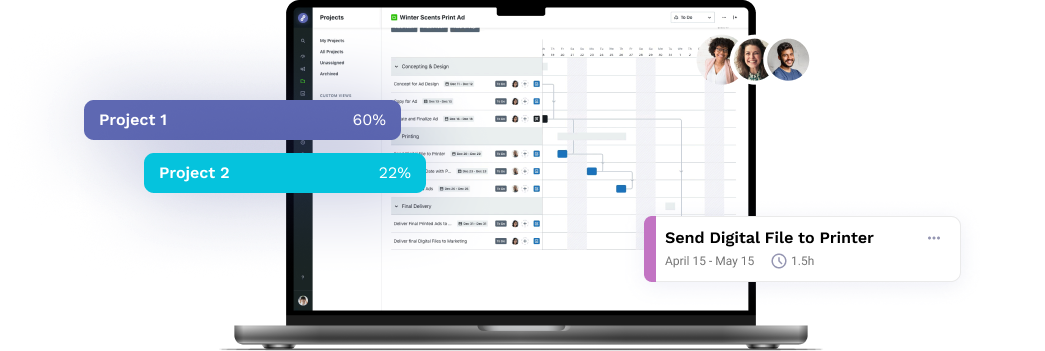
Steve Jobs (who knew a thing or two about marketing) once said: “The most powerful person in the world is the storyteller.” It remains true that highly personalized and data-driven B2B storytelling is the only combination powerful enough to consistently capture your prospects’ attention.
However, it’s easy to forget that your typical B2B audience is full of savvy marketers, sales professionals, and others with experience in those areas. In the same way that lazy outreach, generic ads, and vague wording can’t fool you, your audience has likely developed a very keen sense for marketing BS.
This means we only have one option: Offer our B2B (prospective) customers the truly tailored experience they deserve. We can only do this by using the right mix of tools to properly cater to their individualized needs through B2B brand storytelling.
There’s a lot that goes into crafting a compelling B2B story, so we broke it down step by step, using a fictional (and creatively named) brand called Fictitious Creative. As we build a story, think of them as your prospective customer.
Creating Buyer Personas for B2B Storytelling
Fictitious Creative is a 17-person digital marketing agency that extends across the EU and US. Your first step in creating B2B storytelling that resonates with them is to hone in on the main bidirectional business relationships that define their buying and selling decisions:
| Fictitious Creative has customers who wish to purchase their expert digital marketing services. | Fictitious Creative is a customer of businesses that sell the digital marketing tools they use to provide their services. |
Now that you’ve defined the primary business relationships for Fictitious Creative, you can get more specific with the persona type relevant to you and define accurate buyer personas. In this case, you may wish to promote digital creative operations software to them.
To do so, you must dig deeper into the second type of business relationship for this brand. Success will mean using B2B storytelling to address the part of the equation that connects your business to theirs — digital marketing services.
Fictitious Creative needs state-of-the-art digital marketing tools to:
- Plan for and keep track of the digital creative projects of their customers.
- Provide quick, easy, and collaborative feedback on creative assets.
- Create and replicate creative assets and their variations at scale.
- Store all client creative assets in one secure, but easily accessible, platform.
- Manage access to, track sharing of, and define an expiration date for creative assets.
- Generate reports and analytics on the above, plus track team availability.
Conduct Research on Your Buyer Personas
For strong B2B storytelling, conduct thorough research on Fictitious Creative across various social media platforms and their own website. Then you can determine the agency’s location, contact details, buying motivations, concerns, and part of its clientele.
Upon further investigation of the agency’s personnel on platforms like LinkedIn, you gain a general feel for their age range, gender distribution, hobbies, education, job title, income range, and languages.
Next, make use of every tool at your disposal. Look into Fictitious Creative’s competitors to identify common threads and fill in the blanks. Use survey findings and customer feedback to give a better shape to your buyer persona.
Finally, add the finishing touches to your buyer personas by contacting your Customer Experience/Customer Success team. They can help you identify major pain points and screen your findings for validity.
Image Source: From Research To Results: Using Buyer Personas To Drive Advocate Engagement – Influitive
Only Identify Useful Details About Your Buyer Personas
As the saying goes, “If you can track it, you can map it.” (Alright, maybe it’s not that old, and maybe it’s not an adage either. Still, you get the gist.)
The list of details about your buyer personas that you can access online is practically endless. Remember: Just because you know something about your buyer personas, it doesn’t mean that it’s always useful in your B2B storytelling.
Combine Your Findings to Finalize Buyer Personas
Having gathered a wealth of information about Fictitious Creative, consolidate and finalize your buyer personas. Combine demographic details, buying motivations, concerns, and pain points to create comprehensive profiles.
Perhaps a mid-level executive is keen on creative technologies. On the other hand, a C-level executive likely prioritizes business impact and ROI. We can use both of these profiles to maximize the effectiveness of our story.
Translate Buyer Personas into Business Needs, Goals, and Decisions
With your finalized buyer personas in hand, it’s essential to translate these insights into tangible business needs, goals, and decisions. Visualize the challenges Fictitious Creative may face in their digital marketing projects.
Then outline the goals the agency aspires to achieve. Finally, pinpoint the decisions they need to make in adopting new tools.
Now that you’ve crafted the right personas to target, you can move into designing an overarching narrative.
Building Narratives for Your B2B Storytelling That Align with Your Buyer Personas
The crux of effective B2B storytelling lies in crafting narratives that deeply resonate with your buyer personas. Tailor your stories to address those unique challenges, goals, and motivations. Then position your product or service as the ideal solution.
For Fictitious Creative, you would emphasize how your digital creative software addresses their specific needs. Illustrate scenarios where your tools facilitate collaborative feedback and streamline project planning. By weaving narratives that align with your buyer personas, you capture attention and establish meaningful connections through B2B storytelling.
Let’s dig a little deeper into just how to do that. But before we go further, we must make an important distinction between story and narrative.
Stories are short in length, with a clear beginning, middle, and end. They form the core elements of a narrative. A narrative, on the other hand, is the overarching message you continuously convey to your audience by using stories and constant reminders of your brand narrative.
Now, we can check out three steps for crafting a compelling narrative. Here, we’ll use a couple of notable real-world examples to draw inspiration from Spotify’s “Wrapped for Advertisers” and Slack’s “So Yeah, We Tried Slack.”
Step 1. Get Stakeholder Involvement
We need to start with the source of the messaging that made these iconic narratives possible — the various stakeholders within these companies. If you wish to craft compelling B2B storytelling for your business, you need to engage people from different departments.
They know the business landscape and your target customers’ needs the best. They’ll be able to prioritize creating an impactful and deeply authentic narrative more than anyone else.
Get your stakeholders together and communicate the importance of crafting a true-to-brand narrative that will serve as the direction for all corporate communications moving forward. The stronger the input, feedback, and results you get from stakeholders, the better chances your messaging and narrative will have of landing well with consumers.
Actionable Steps:
- Conduct executive workshops or strategy sessions involving stakeholders to discuss and define the core narrative in a way that feels authentic to the brand.
- Develop clear guidelines that outline the key messaging and values the narrative should convey and include them in all corporate communications.
- Schedule regular check-ins with stakeholders to incorporate their insights, and keep the narrative aligned with the evolving business landscape.
Step 2. Know Your Audience
Take the time to research your audience’s core needs, motivations, and aspirations. That work gives you the knowledge and power you need to create B2B storytelling narratives that resonate with your target audience.
Looking at the “Wrapped for Advertisers” and “So Yeah, We Tried Slack” campaigns, it’s evident that some very well-calculated aspects are responsible for their success.
In Spotify’s case, they leveraged B2C familiarity and tapped into an existing customer base with recognition and affection for the brand. They natively integrated their B2B offering into Wrapped and offered advertisers instant access to Spotify’s valuable customer base.
Their campaign appealed to advertisers since it followed a data-driven approach with plenty of social media proof and positive responses. All the while, they maintained Spotify’s distinct brand voice.
Slack was wildly successful for different but equally exciting reasons. They crafted a hilarious mockumentary-style video advertisement using an existing customer of theirs, Sandwich Video, to showcase why Slack is leagues above its competition.
Notice how they use humor in their B2B storytelling to break through the typically dry tone of B2B marketing. They really deliver with a video that emphasizes the core of their offering while addressing pain points and showcasing their product using an already-existing customer. Genius!
Actionable steps:
- Conduct thorough customer market research to understand the diverse needs, motivations, and aspirations of your target audience.
- Create a narrative that would convince you to buy your product — whether it’s one that showcases your brand and product offering(s), makes you laugh, offers you important technical information upfront, or all the above.
- Evaluate the narrative’s appeal by testing it across different niche situations and demographics to see if it translates well and resonates with the different audiences you wish to target.
Step 3. Think Positively (and Plan Accordingly)
A positive mindset is essential for crafting compelling narratives. When you approach B2B storytelling with a focus on the good, you attract more positive experiences and outcomes.
However, this doesn’t mean ignoring challenges or pretending they don’t exist. It’s more about acknowledging them and finding the silver lining, the learning opportunity, or the opportunity to grow and overcome.
Still, don’t dwell too much on challenges and obstacles. Shift your attention to the positive outcomes and benefits of your products or services. Highlight how your solutions can help businesses achieve their goals and overcome challenges.
Then tap into the emotions of your audience by using words that evoke feelings of hope, inspiration, and empowerment. This will make your narratives more engaging and memorable.
Actionable steps:
- Conduct storytelling workshops to brainstorm and identify positive, inspiring stories within the company and industry.
- Develop and update a story repository of authentic stories that align with the brand values.
- Provide training for those responsible for crafting and delivering positive narratives.
Making a Compelling B2B Narrative
Storytelling (even B2B storytelling) comes in all shapes and sizes. Still, there are some universal elements that every remarkable story follows:
- They often include a protagonist living in a peaceful world where everything is going well until they encounter an insurmountable obstacle.
- After some initial hesitation, the protagonist goes on a journey to self-discovery and growth.
- Their path is full of challenges and unpredictability, and they eventually rise above it all and overcome the difficulties they initially faced.
- Finally, they take the lessons they learned with them and move on to the next chapter of their life, better equipped to deal with future hurdles.
This example illustrates the need for a central figure, a significant challenge, the payoff of human ingenuity and persistence, and the rewards reaped at the end. The variation you follow depends on your business needs, your industry, and most importantly the specific traits of your target audience.
Once you have followed the three steps outlined above and crafted your core messaging, you can start working on ideas about how you would like to share your narrative with the world.
Iterating on Feedback in Your B2B Brand Storytelling
Customers’ needs and wants evolve, and so should your B2B storytelling strategy. Actively seek feedback from your audience and use it as a catalyst for continuous improvement.
Whether through direct interactions, surveys, or monitoring social media engagement, stay attuned to the changing needs and preferences of the audience. By incorporating feedback into your storytelling approach and combining it with data, you demonstrate a commitment to understanding and addressing the dynamic nature of your audience.
Navigating Real-World Constraints with Practical Strategies for Limited Resources
The path to highly effective B2B storytelling is demanding. We understand not every marketer has abundant resources to make it happen. Let’s explore practical strategies to tailor your storytelling within real-world constraints.
1. Prioritize Your Efforts
Identify key accounts or prospects that hold significant potential. Focus your personalized B2B storytelling efforts on these high-priority targets, ensuring maximum impact with limited resources.
2. Utilize Automation Wisely
Leverage marketing automation tools to streamline repetitive tasks, such as social media monitoring or basic data collection. This allows your team to allocate time more efficiently.
3. Lean on Existing Data
If you lack the bandwidth for extensive research, make the most of existing customer data. Analyze past interactions, purchase history, and feedback to shape your narratives effectively.
4. Leverage Cost-Effective Tools
Explore budget-friendly tools that can assist in data gathering, analytics, and social listening. While they may not provide all-encompassing insights, they can still offer valuable information without breaking the bank.
5. Optimize as You Iterate
Start small, learn from initial efforts, and iterate. Continuous optimization is key to refining your B2B storytelling strategy. As resources become available, you can expand and enhance your approach.
Simplifying and Automating Your B2B Storytelling Process with Powerful Tools
In the realm of B2B marketing, storytelling stands as a powerful tool. B2B brand storytelling enables you to connect with your audience, build trust, and drive business growth.
Remember, a compelling B2B narrative isn’t just about highlighting features and benefits; it’s about creating an emotional connection with your audience. Tap into the universal themes of the human condition and show how your brand can empower businesses to overcome challenges and achieve their goals.
At Lytho, we stand ready to enhance your creative workflow and unify your brand collateral under a single, uniform platform. Schedule a demo to explore how our solutions can elevate your brand narrative, bringing stories to life with impact and authenticity. We look forward to connecting with you on the B2B storytelling journey!
Do you want to give yourself and your creative team more room for creative stimulation by automating the boring stuff? Lytho helps you streamline your entire workflow and harmonize all brand collateral under a single, uniform platform. Feel free to reach out to us by scheduling a demo and learning how our creative solutions can boost the effectiveness of your creative projects. We look forward to speaking with you!

Ready to simplify your creative operations and start having a little fun at work again? Schedule time to talk with us.
Let us show you how Lytho’s Creative Operations Platform helps in-house creative and marketing teams do better work, ease the stakeholder experience, and stay on brand.
Schedule a Demo posted by
posted by 
